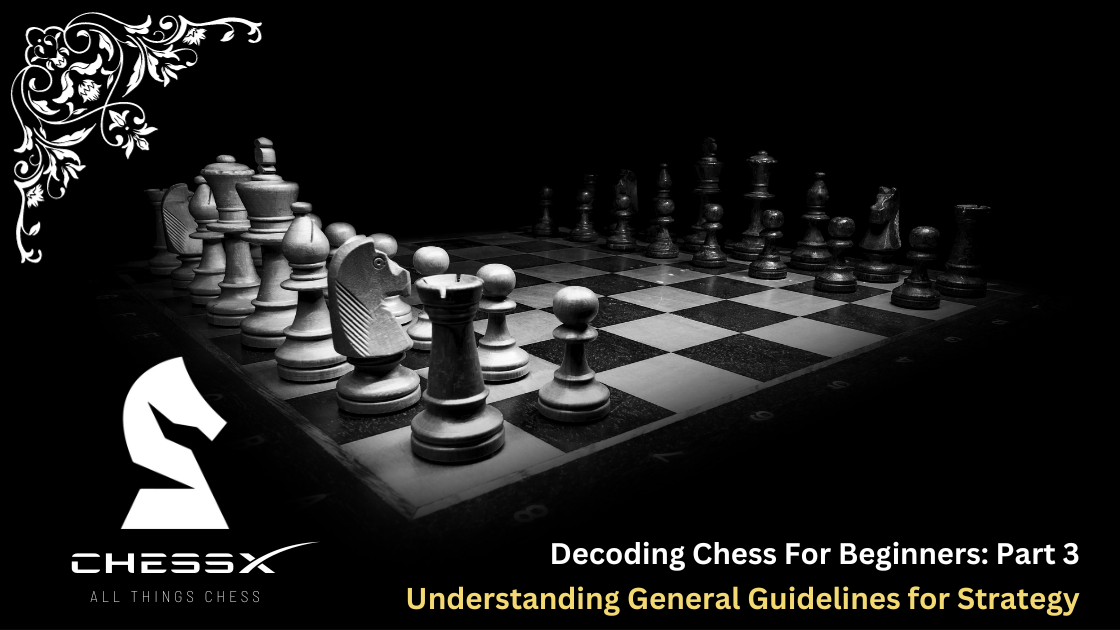Decoding Chess for Beginners: Understanding General Guidelines for Strategy

In the third installment of the Chess for Beginners series, we delve into the essential guidelines for chess strategy. This blog explores the significance and impact of strategic considerations on the outcome of the game. To gain the most from this discussion, we encourage you to read the complete blog.
Ah, the love of the game! Chess offers a myriad of methods to play, drawing thinkers from around the world. It evolves continuously after centuries of play, proving that no particular style is significantly superior. Surprisingly, the FIDE, or World Chess Federation, ranks as the third-largest sporting organization globally, following the International Olympic Committee and FIFA.
Representing over one hundred and eighty nations and counting, FIDE stands as a testament to a rich history, woven with diverse cultures. The dynamic nature of chess is no surprise, bringing together players from various ethnic backgrounds, creating a blend of people and intellect at a single table.
Chess mirrors life's interests, where players bring excitement, emotion, and diverse strategies. This book aims to help you understand these perspectives and the nuances beneath them. Let's explore some general rules to prepare you for becoming a seasoned player.
To comprehend what lies ahead, let's clarify that strategy and tactics are as distinct as homemade and store-bought apple pie. You'll know the ingredients, but it's up to you to discern why store-bought tactics are temporary, while homemade strategies are long-term investments that should evolve over time.
The purpose of strategy can be narrowed down to creating one or more of these advantages:
- More material (force; strength in piece values)
- Superior piece development
- Superior pawn structure
- More territory (space)
- Safe king position (usually when castled)
Specific strategies will be discussed in the upcoming chapters. For now, let's focus on general concepts. It's crucial for you to recognize potential advantages in gameplay and use these dynamics to develop a plan, gaining an edge over your opponent in that window of opportunity.
In the constant battle between players adapting their advantages for new ones, these small details epitomize benchmarks of great play.
Target Development
Have you ever wondered how most millionaires attain their prestigious status? It's typically not through a stroke of luck, like winning the lottery, hitting the jackpot in the stock market, or stumbling upon an idea or skill that becomes wildly popular and propels them into wealth. Such cases are rare and lack the consistency that the average person can emulate for comparable results.
Instead, most millionaires achieve financial success by diligently saving small amounts of money and pinching pennies whenever possible. Over time, with skill and success, they elevate themselves into positions of distinction through the effective utilization of their resources. While keeping their overarching goal in mind, they understand that the most reliable strategy involves maximizing small steps as they present themselves.
To develop a consistent mastery of chess and gain proficiency in contending with various play styles, adopting a similar strategy is essential. While the ultimate goal is to achieve checkmate and defeat your opponent's king, it's unrealistic to expect quick victories every time. To consistently improve outcomes, the key lies in gradually building a series of small advantages through well-planned positioning.
A crucial approach to support your chess game is the ability to identify targets or weak points within your opponent's formation. Cultivating a mindset where you consistently seek to exploit your enemy's weaknesses becomes paramount.
This attitude should fuel your eagerness to create and capitalize on these targets, maintaining a relentless effort until you maximize every potential advantage. There are two fundamental ways to accomplish this: first, through exploiting weak pawns, and second, by targeting weak squares.
Weak Pawns

Weak pawns are those vulnerable to attack, left unprotected either in isolation or at the base of a fragile pawn chain. These vulnerabilities may result from an opponent's mistake, but relying on such errors is not a reliable strategy. Instead, you must proactively create these weaknesses for yourself, and that is the key to this strategic approach.
Identify weak pawns in your opponent's camp to establish targets and launch a forceful attack. It's a straightforward concept, and a well-known and highly effective method for achieving this is the 'minority attack,' which unfolds as follows:
A well-known and extremely useful method for doing this is a strategy known as a ‘minority attack.’ The minority attack follows as:

Employ pawns (2) to attack a pawn majority (3), with the goal of leaving your enemy with weak squares and opening up lines.
To access the entire blog, subscribe to our premium plans today and elevate your chess game to the next level. Get ChessX for all things chess.